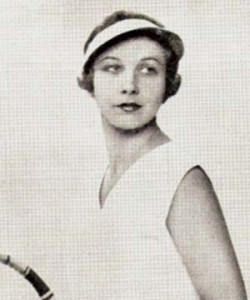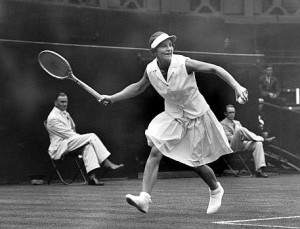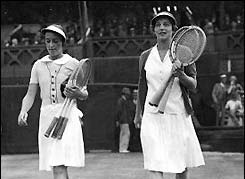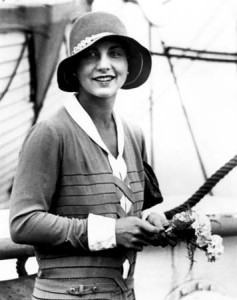Queens of the Court: Helen Wills Moody, Shades of Garbo

Helen Wills Moody won 19 Grand Slam singles titles during her career.
The relatively unknown Molla Mallory holds the record for the most U.S. Open singles titles—eight. But it was the remarkable Helen Wills Moody who, at the age of just 17, relieved Mallory of her U.S. crown in 1923, and went on to hold the record of 19 singles Grand Slam titles for a third of a century.
This is the second in a series celebrating some of the most inspiring and influential women to have played tennis.
All the signs were that Helen Wills would make a success of her life.
She graduated from one of California’s top schools and won an academic scholarship to study fine arts at the University of California. She went on to be honored as a Phi Beta Kappa, one of the most prestigious liberal arts and sciences awards in the United States.
She was a highly accomplished painter, a successful writer, and an excellent horsewoman.
She rubbed shoulders with kings and prime ministers, was painted by Diego Rivera, and was admired by Charlie Chaplin.
But the early signs did not suggest a career as one of the 20th century’s most successful sportswomen, for she was a small and relatively fragile girl. She was, though, blessed in her parents.
Her father, Clarence Wills, was a doctor, and he got his daughter interested in outdoor activities, particularly swimming and riding. When she was eight, he bought her a tennis racket and played with her every day.
Her physical health improved rapidly, and at just turned 14 she was invited to join Berkeley Tennis Club. Soon, her trademark concentration, power, and speed came to the fore, and she began competing on the national circuits.
In 1921, at just 16 years old and still only 5’0″, she went to the east coast for more competition, and saw the most famous tennis player of the day, Suzanne Lenglen, for the first time.
The sick Lenglen was jeered off court by the American crowd, having defaulted against home favorite Mallory. The very next year, Wills was herself up against Mallory in the U.S. National final, and recorded her last ever loss to her illustrious countrywoman.
Wills made that journey east with her mother, who provided the emotional support that her daughter needed. The teenager was a quiet and reserved girl who admitted in later years that she found relief from an innate melancholy in her painting and her tennis. The presence of her mother provided Wills with both mental strength and friendship.
By the end of 1922, Wills was ranked third among American women. More importantly, she had grown a full seven inches and had gained 25 pounds. She was ready to embark on one of the finest decades of tennis success ever achieved by a man or a woman.

Helen Wills Moody won her first Grand Slam title at age 17 and her last at age 32.
Between 1923 and 1933, Wills won 17 of her 19 singles Slam titles and was runner up in two more. (And this was at a time when players did not take in the Australian championships because of the time and distances involved in reaching them.)
Wills also won gold in both the singles and doubles at the Paris Olympics. She held the No. 1 world ranking throughout, except for 1926, and—most remarkable of all—she achieved a 180-match winning streak between 1927 and 1933, without losing a set.
That gap in 1926 was significant in more ways than one. It marked an absence from her C.V. of all three majors because she needed an emergency appendectomy during the French championships. Wills was forced to withdraw from Wimbledon and, after attempting a come-back prior to the U.S. Open, was advised by her doctor to withdraw from there, too.
The Wills appendix, it transpired, was to deprive tennis of one of the most fascinating head-to-heads of the century.

Helen Wills Moody (right) and Suzanne Lenglen combined to win 30 Grand Slam titles between 1919 and 1938.
Wills and Lenglen dominated the inter-war years, between them winning 30 grand slam titles between 1919 and 1938. Yet they played each other only once, and it was not in one of those majors. Billed as “the match of the century”, it took place in Cannes in February 1926.
Wills made her way to France that year to pursue her painting and her education. She was also ready to take up the Lenglen challenge. The media went into overdrive at the prospect of Lenglen, the best female player in the world, asserting her superiority over the 20-year-old who had already won three US titles.
The encounter was given added spice by the contrasting characters and styles of play of the two women. Lenglen, then 26 and the reigning French and Wimbledon champion, was renowned for her glamour, grace, flamboyance and tactical brilliance. Wills was more statuesque, physically stronger, but quiet and serious.
Lenglen was the favorite to win, and she did. But it was a closely fought battle that flagged up to the tennis world that Wills was ripe to take over Lenglen’s crown. But before the rivalry could get under way, Wills was incapacitated by her appendix, Lenglen turned professional, and the two never met again.
Wills, though, did meet another significant person again after Cannes. A young businessman in the crowd, Frederick Moody, introduced himself after the match, and Wills became Wills Moody in 1929.
By her return to tennis in 1927, Wills was unbeatable. Not only did she win all three slams between Wimbledon that year and Wimbledon in 1930, she did so without conceding a set.
The Wills game had become truly formidable. She routinely practised her tennis against men, which helped to develop the powerful, athletic and unflagging play that dominated all-comers. Indeed as late as 1933, she played, and beat in straight sets, the eighth ranked American male player Phil Neer in an exhibition match.
On both the forehand and backhand, she was able to drive the ball with speed, pace, and depth, and had a serve that could pull her opponent wide of the tramlines. Though she didn’t attack the net with any frequency, she was also a capable volleyer.
Time magazine, which featured Wills Moody on its cover twice, said: “There was nothing frivolous about Little Miss Poker Face [as she was known]. She stood her ground like a tank, drilling out bullet serves and powerful baseline drives.”
The lack of emotion on court at which this extract hints was interpreted by many as an aloof coolness, and neither endeared her to the media nor won great warmth from spectators.
However, it did reflect Wills Moody’s naturally introspective personality, as well as her ability to channel herself with remarkable concentration into her tennis. In her autobiography, she said, “I had one thought and that was to put the ball across the net. I was simply myself, too deeply concentrated on the game for any extraneous thought.”
Hazel Hotchkiss Wightman, a former American champion and the woman behind the Wightman Cup, had reason to understand Wills Moody better than most. She, too, had taken up tennis to improve her health, and also went to the University of California: “Helen was really an unconfident and awkward girl…I thought of Helen as an honestly shy person who was bewildered by how difficult it was to please most people.”
Even some of Wills Moody’s fellow American players were less than enamored by her. Helen Jacobs—and indeed the American crowd—resented her retirement with back pain from the 1933 U.S. Open final. Wills Moody needed a year out of tennis to recuperate from the injury, and she refused ever to play in the U.S. Open again.
She did, however, win Wimbledon in 1935 and, after another three years away from tennis with back problems, in 1938. Both wins were against Jacobs. They were also her valediction to tennis.
Alice Marble filled, with Jacobs, the U.S. Open vacuum left by Wills Moody, and it is Marble who is credited with dubbing Wills Moody the “Garbo of tennis.” No doubt she intended it as a slight.
But it provides an excuse to look at Wills Moody from a different perspective. There are many photos of the reclusive champion, and even a little blurry film footage. Both media reveal a beautiful, elegant, glowing woman. Her features, like her figure, were classically proportioned.

Helen Wills Moody displayed grace, beauty and glamour both on and off the tennis court.
In style, too, she had class. Not for her the bohemian bandanna and flowing coat sported by Lenglen. Wills Moody wore a pleated knee-length skirt, white open neck blouse, and a white visor—a trend-setter of her day.
She had an effortless and unhurried walk, a wonderful bearing, and yes, looked remote.
The beginning of this piece referred to Charlie Chaplin’s admiration, and the context for that reference is appropriate here. He is quoted as saying that the movement of Helen Wills playing tennis was the most beautiful sight he had ever seen.
In retirement, Wills Moody set up her own art studio, wrote extensively, and played tennis into her 80s. She continued to follow the game in her later years and admired the tennis of Martina Navratilova. As well she might. It had taken more than half a century for a woman to win more Wimbledon singles titles than the multi-layered Wills Moody. Navratilova was that woman.
What more might burnish the Wills Moody reputation? That she reached the final of every Grand Slam singles event she played during her career? That she played in the Whiteman Cup 10 times and lost only two matches? That she won 12 Grand Slam doubles titles? That she wrote and illustrated her own coaching manual?
Or that, when she died at 92, she left her $10 million fortune to the University of California, where she is now remembered by the Helen Wills Neuroscience Institute?
In truth, there are few either before or since who have left such a complete legacy. One of them may be her famous contemporary, the charismatic, Suzanne Lenglen.
Check back on October 30 as the next article in the “Queens of the Court” series will feature Suzanne Lenglen.
Clarabella Bevis is a regular tennis contributor for Bleacher Report and has graciously allowed her work in the “Queens of the Court” series to appear on Sports Then and Now.









